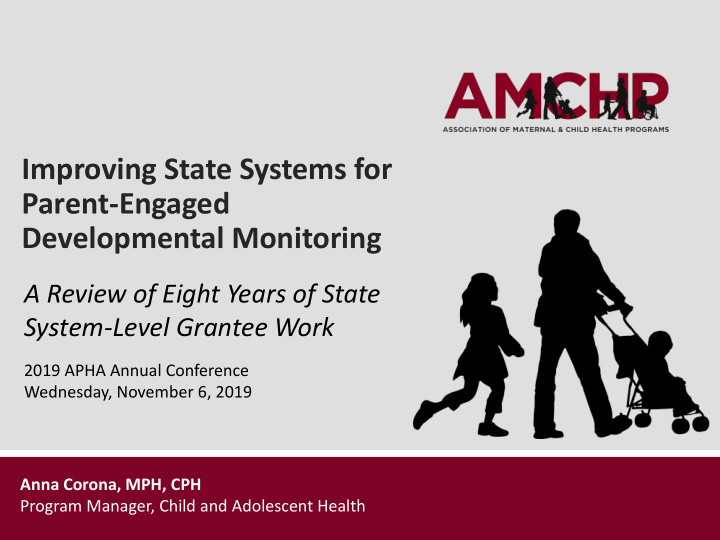



Improving State Systems for Parent-Engaged Developmental Monitoring A Review of Eight Years of State System-Level Grantee Work 2019 APHA Annual Conference Wednesday, November 6, 2019 Anna Corona, MPH, CPH Program Manager, Child and Adolescent Health
AMCHP is national resource, partner, and advocate for state public health leaders and others working to improve the health of women, children, youth and families, including those with special health care needs . 2
Learning Objectives ✓ Describe three impact points for improving states system capacity for ✓ Discuss practical examples of integration of the CDC’s Learn the Signs. Act Early. ( LTSAE) developmental monitoring tools into state systems ✓ Identify one opportunity to integrate LTSAE developmental monitoring materials into efforts for improving early childhood developmental monitoring and early intervention
Learn the Signs. Act Early. Initiative Goal : To improve early identification of developmental delays and disabilities, including autism, by promoting developmental monitoring and screening so children and families can get the services and support they need
Developmental Monitoring Resources cdc.gov/ncbddd/actearly
LTSAE State Systems Grants Grants awarded to states/jurisdiction to: ✓ Strengthen state and community systems for early identification ✓ Improve coordination of early intervention services for children with signs of ASD/DD ✓ Ensure sustainability of efforts
The Act Early Initiative: A 15-year Journey
The Legacy of Eight Years of Work
Survey Outcomes 94% of grantees felt that they met their grant objectives Over 90% of grantees reported improved provider knowledge and training on the importance of developmental monitoring and screening 82% of grantees reported that the grant helped create, strengthen, and/or sustain partnerships 94% of grantees believed their grant-related efforts remained sustainable or somewhat sustainable
Findings: Three Impact Points Activated stakeholders and Formalized developmental monitoring and early strengthened partnerships identification as a priority Increased awareness among caregivers and providers on the importance of developmental monitoring and early identification
Increased awareness among caregivers & providers Abridged Case Study: Massachusetts Act Early Team Developed and broadcasted a program about early childhood development for families of young children in eight languages on cable television stations across the state and YouTube The shows 1) educated families about healthy developmental milestones based on the CDC’s LTSAE materials and 2) provided instructions on what to do about red flags or potential concerns in young children. More than 3,600 views of cable and YouTube shows during launch week; more formal evaluation forthcoming
Activate Stakeholders & Strengthen Partnerships Abridged Case Study: Oklahoma Act Early Team Expanded the Community Screening Partner Network, a selected group of targeted individuals at an agency or organization who routinely conduct developmental screening and can easily incorporate screening specifically for autism. Trained, supported, and provided materials to Community Screening Partners The expanded CSP network resulted in creation or changes in policies and practices across member’s organizations related to conducting developmental monitoring and screening
Formalized developmental monitoring and early identification as a priority Abridged Case Study: Virginia Act Early Team Created an Act Early team of 26 members representing state agencies, advocacy group, families, and medical professionals Convened the team to conduct a strategic planning process to improve the early identification of children with ASD and support for their families Developed a strategic planning document that provided direction for the state to address priorities collaboratively Used the strategic planning document to apply for and receive funding to implement the activities outlined in the strategic plan As a result of grant funding, the state was able to expand diagnostic capabilities in three VA communities
In Conclusion… ✓ The LTSAE State Systems Grants were a successful mechanism for strengthening state and community systems to provide early identification and coordinate services for children with ASD/DD ✓ Although approaches differ across states, they can be adapted and replicated to aid state systems in increasing developmental monitoring and screening for early identification
Resources to check out: ✓ Leverage the freely available LTSAE resources to sustainably integrate developmental monitoring within early childhood systems that already exist in your state (WIC, Head Start, Home Visiting, Health Systems, etc.) ✓ Check out the full interactive Legacy Product for case studies highlighting how several states achieved sustainable outcomes with a small amount of funding
Thank you! Anna Corona, MPH, CPH acorona@amchp.org Program Manager, Child and Adolescent Health
Recommend
More recommend